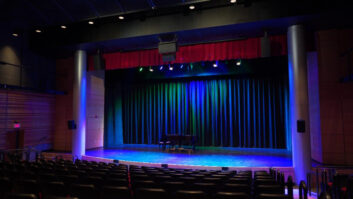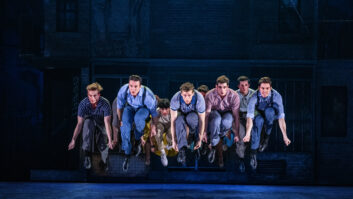AV wizardry has been part of theatre for decades. Sound and lighting are important considerations in any production, and theatregoers are quite familiar with the use of projection and multimedia in all sorts of performances.
The Covid-19 pandemic has already generated more opportunities for AV. Digital signage is being used to remind people about social distancing rules and room capacity, while streaming technology is providing live entertainment remotely.
But as we navigate our way out of the pandemic, we need to consider what opportunities exist for AV in theatre in a post-pandemic world.
Dave Young, head of production, ICC Belfast | Waterfront Hall | Ulster Hall, acknowledges that the AV and technical production element of events has not stood still during Covid-19. “Post pandemic, there will be a pent-up demand for live events and in-person experiences that can undoubtedly be enhanced by cutting-edge production that takes events to the next level. As an industry, the future presents some incredibly exciting opportunities.”
Andy Stone, managing director, Drama By Design considers that greater creativity around the use of streaming can open up new production possibilities. “The AV industry has been working with video and audio streaming for some years which, combined with collaborative learning and meeting solutions could offer some great options for theatre. Yes, the seating capacity is likely to be reduced, but there is nothing to stop audiences, and even potentially performers, from being involved with live events from remote locations. If the theatre industry is smart, they could develop productions based around this format where the local and remote audience members can participate in the production. Education has been working on this blended approach for some time, accelerated by Covid-19, and it’s a great way of maintaining engagement with your audience.”
Ray Meadham, CEO, Multiview Media, has observed that the hybrid model being explored by many venues is to have small audiences and add a streaming facility. This includes installing some fixed cameras for general coverage and options for roving cameras all focused to deliver a streamed example of the show. “Streaming to global single-angle sites does not always generate subscribers or financial returns. It’s more beneficial for theatres to develop their own streaming system. Multiview Media offers that option and 20 per cent longer fan engagement compared to single-angle streaming.”
“We will see a continuation of the trend that we saw leading up to 2020,” says Felix Knight, Managing Director, Lightware Visual Engineering UK & Ireland. “What we were seeing was an increasing integration of AV technology into theatre environments. As an example, you can look at the way projection mapping began to become more widespread. This is a technology that can achieve a lot of what a fully featured lighting rig can do, with additional capabilities in terms of projecting visuals on the stage, sets and even the performers. Before Covid-19, we were just beginning to see creative directors become more comfortable with this kind of tech and I believe we will see it pushed further. Imaginative use of new technology always has the chance to create an experience that is unique and unmissable.”
Bringing the theatre home
Although streaming is no longer new technology, it has nevertheless offered a lifeline between theatres and audiences. However, one of the joys of a visit to the theatre is in the immersive experience, and it is hard to imagine that a similar experience can be delivered at home.
“Theatres need to be more imaginative,” says Stone. “In my view, live streaming of theatre performances is not very exciting and seems a bit pointless. Performances need to be designed around this medium to ensure audiences feel part of and can be involved in the performance. It’s difficult for them to be immersive, but they can definitely be more interactive and collaborative.”
This kind of interaction includes creating emotional connections, as Young advocates. “The period of extended closure gave us a chance to look at how we delivered this in a new light. We help harness these emotional connections and sensory motivators through our LED stage lighting, PA system, 4K broadcast camera and radio microphones to build an immersive and exciting atmosphere. The combined impact of these production elements creates a sense of thrill, reminiscent of when the theatre lights dim, and the curtain goes up.”
Meadham believes that multi-angle streaming is another way of delivering a more immediate experience to online audiences. “The advent of multi-angle streaming allows the viewer some interaction, but not too far removed from the single angle experience that they are used to. The addition of high-quality audio such as Dolby will add an auditory experience alongside the visual.”
Theatre in a digital world
Streaming of live events has been an important part of the performing arts landscape over the past year and, undoubtedly, it has helped people stay connected and involved. In addition, because live streams are more accessible, theatre is now available to greater audiences. So, whilst live streaming may have been introduced as a stop-gap in many cases, it is interesting to ponder whether it will continue to have a place going forward. Afterall, most theatregoers would say that part of the pleasure of theatre is being at the venue.
This is an opinion shared by Stone. “I have never seen streaming of live performances as a strong or long lasting medium. For me, the beauty of live performances is being there. I think they will probably continue, but my preference would be to have something more interactive or blended.”
Young believes that done properly, streaming can play an important role in theatre’s offering. “The buzz of a live performance is inimitable. However, the evolution of digital events presents multiple opportunities for up-and-coming artists as well as for fans to experience a performance at a time and a place that suits them. Audiences will have a lot more choice and in order to stay ahead of the curve, theatres need to be prepared to innovate and adapt to meet this demand.”
Meadham agrees. “There is a need for a single and effective streaming system that can be owned by the venue to stream direct to audiences, build subscribers, and create a digital community of viewers. Not everyone can attend every show and the ability to deliver a streamed version of the show after it has happened or geolocate it, can expand the reach, revenue, and reaction of the theatregoers.”
Whilst technology can do a great deal to help theatres reach audiences, Knight suggests that directors also need to play their part. “The big change in the future will be directors designing their productions from the outset with regards to how things will look both for the audience in the theatre and the audience at home. Most of us are familiar to some extent with multicamera TV shows filmed in front of live audiences and I anticipate a lot of techniques and skills from that environment will be used more in live theatre as well.”
Levelling up while locking down
Despite the economic uncertainty faced by theatres over the past year, some venues have used the long closures to upgrade their facilities with a view to boosting revenue.
Young’s team has been especially productive. “Significant investment in hardware and software has been made in both the Waterfront Hall and Ulster Hall to equip the venues with state-of-the-art digital event facilities. Our commitment to continuous improvement means that when we can safely welcome visitors back, we can provide expert support and guidance on how to combine digital and in-person experiences to take events to the next level.”
Stone observes that despite the clear advantages of making improvements, some theatres don’t appear to be looking at changing their model after Covid-19, and are instead thinking only of getting back to business as usual. “I think this is a mistake. Most other industries have taken the opportunity to adapt their business model to enable them to survive a similar event in the future.”
Long-term benefits
Young agrees that making changes now with an eye on future aspirations is important. “We need to keep developing provisions for digital events that are designed with the end to end customer journey in mind. If every touchpoint is considered both individually and as part of the overall process to ensure it is straightforward and enjoyable, there are huge long-term benefits for theatres to take advantage of.”
According to Knight, theatres can achieve long-term gains by future-proofing their network infrastructure. “From the conversations I have been involved in over the years, there is a realisation from theatre managers and theatre architects that AV and data network infrastructure is increasingly important to consider. Wherever you have network, you have AV. If you need to scale the system up, you can. As long as your network has capacity you can just add more endpoints. Lightware has an AV over IP platform called UBEX, which is the lowest latency you will find in an AV over IP technology and can transmit the highest bandwidth HDMI 2.0 signals completely uncompressed.
Affordable art
The idea of making upgrades might be appealing, and possibly even a revenue generator, but for an arts industry familiar with tight budgets the cost of the latest technological enhancements could be limiting.
Stone points out, “Smaller local theatres are going to find it more difficult as small audiences mean reduced revenue. That said, AV systems for streaming performance aren’t prohibitively expensive and theatres can apply for government or arts council funding for this.”
Indeed, Young confirms that such funding made many of his upgrades possible. “A successful application to the Arts Council of Northern Ireland’s Organisation Emergency Programme led to the launch of ‘Live from the Ulster Hall’ in December 2020, catapulting our 158-year-old concert hall into a new era of streaming and on-demand content. This project created an affordable route to market for the local arts industry, providing homegrown talent the opportunity to engage their audiences via digital platforms.“
In addition to external funding, Meadham is of the opinion that theatres themselves have it within their power to fund upgrades by increasing their reach and growing their revenue streams. “Many theatres wrongly maintain that if they stream online, people will not attend in person. The cost of cameras, streaming infrastructure, etc. is not prohibitive to delivering a quality service and can quickly pay for itself if it expands the reach outside the capacity of the venue.”
Lift the shutters
As we navigate our way out of the pandemic and box offices lift the shutters, the performing arts industry can continue to build on the strategies devised to manage the lockdown. Likewise, the AV industry can help theatre develop in ways that enhance the theatre experience both at venues and at home.







